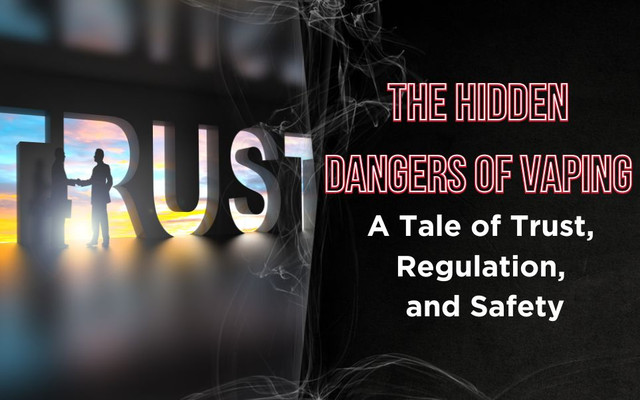
In the summer of 2019, a mysterious wave of lung injuries swept across the United States, leaving doctors, regulators, and vapers scrambling for answers. Young adults, like 19-year-old Fabian Castillo from Southern California, found themselves gasping for air, their lungs ravaged by a condition that baffled medical professionals. Castillo, who had turned to a marijuana vape pen to ease his anxiety, ended up in the emergency room, his X-ray revealing severe lung damage (Ferguson et al.). What started as a quest for calm became a life-threatening ordeal, linked to a growing epidemic known as E-cigarette, or Vaping, Product Use-Associated Lung Injury (EVALI). This outbreak, which peaked in September 2019, hospitalized over 2,800 people and claimed 68 lives by February 2020, exposed a dark underbelly of the vaping industry: the dangers of unregulated, illicit products (Centers for Disease Control and Prevention).
The Culprit: Vitamin E Acetate and Illicit THC Vapes
The Centers for Disease Control and Prevention (CDC) launched a nationwide investigation to uncover the cause of EVALI. Their findings pointed to a single, insidious ingredient: vitamin E acetate, a thickening agent commonly used in illicit THC-containing vaping products. This compound, safe when ingested or applied to the skin, proved toxic when inhaled, interfering with normal lung function. Laboratory tests confirmed its presence in bronchoalveolar lavage fluid from 48 of 51 EVALI patients, while it was absent in healthy controls (Centers for Disease Control and Prevention). The CDC’s data also revealed that over 80% of EVALI cases involved THC vapes, particularly those sourced from informal channels like friends, family, or online dealers.

The dangers didn’t stop at vitamin E acetate. Tests conducted by CannaSafe, a leading cannabis testing laboratory, uncovered a toxic cocktail in bootleg THC vape cartridges. These unregulated products, often masquerading as popular brands like Dank Vapes, contained pesticides like myclobutanil, which transforms into hydrogen cyanide—a deadly poison—when heated (Ferguson et al.). CannaSafe’s analysis of the vapor itself, a pioneering effort at the time, revealed additional hazards, including formaldehyde and carbon monoxide, particularly when cartridges were heated at temperatures higher than recommended. These findings underscored a critical truth: the black market was flooding the vaping world with dangerous, untested products.
A Tale of Two Markets: Illicit vs. Regulated

Fabian Castillo’s story is a cautionary one, but it also highlights a broader divide in the vaping industry. While illicit THC vapes were driving the EVALI crisis, regulated products from licensed dispensaries tested clean, showing no traces of vitamin E acetate, pesticides, or heavy metals (Ferguson et al.). This stark contrast points to the importance of self-regulation within the cannabis and vaping industries. Organizations like CannaSafe are working to improve safety standards, testing products to ensure they meet rigorous quality controls. Their efforts, combined with law enforcement crackdowns on illicit suppliers, have contributed to a decline in EVALI cases since their peak in 2019 (Centers for Disease Control and Prevention).
 Yet, the CDC’s messaging during the outbreak wasn’t without flaws. Despite the overwhelming evidence linking EVALI to illicit THC vapes, the agency continued to cast suspicion on nicotine vapes, even though no clear connection was established. This ambiguity fueled public confusion, unfairly tainting the reputation of regulated nicotine products. The lesson here is clear: not all vapes are created equal, and consumers must be vigilant about where their products come from.
Yet, the CDC’s messaging during the outbreak wasn’t without flaws. Despite the overwhelming evidence linking EVALI to illicit THC vapes, the agency continued to cast suspicion on nicotine vapes, even though no clear connection was established. This ambiguity fueled public confusion, unfairly tainting the reputation of regulated nicotine products. The lesson here is clear: not all vapes are created equal, and consumers must be vigilant about where their products come from.
The Path to Safer Vaping: Choosing Trusted Brands
The EVALI outbreak serves as a stark reminder that vaping, while often marketed as a safer alternative to smoking, is not without risks, especially when unregulated products enter the equation. For vapers and cannabis users, the safest path forward lies in choosing products from respected, reputable brands. Licensed retailers and manufacturers adhere to strict safety standards, ensuring their cartridges are free from harmful additives like vitamin E acetate or pesticides. By contrast, black-market products, often sold at “pop-up shops” or through informal networks, offer no such guarantees, putting users at risk of severe health consequences (Centers for Disease Control and Prevention).
Lessons Learned and Moving Forward
The EVALI outbreak of 2019 was a wake-up call for the vaping community, regulators, and public health officials. It exposed the perils of an unregulated black market and highlighted the need for stronger oversight and consumer education. While the industry has made strides (thanks to testing labs like CannaSafe and increased law enforcement action) challenges remain. Vaping devices can still expose users to harmful compounds like formaldehyde or acrolein if misused, and the long-term health effects of vaping are not yet fully understood (Ferguson et al.). For now, the best defense is knowledge: stick to regulated products, avoid modifying devices or e-liquids, and consult healthcare professionals if you experience symptoms like coughing, shortness of breath, or fever.
As we reflect on the EVALI crisis, we’re reminded that vaping, like any consumer product, requires responsibility and discernment. By supporting reputable brands and advocating for stronger industry standards, we can help prevent future outbreaks and ensure that vaping remains a safer option for those who choose it.
Conclusion
The story of EVALI is one of tragedy and triumph, a tale of lives disrupted by dangerous products and an industry rising to meet the challenge. By learning from the past and prioritizing safety, vapers can enjoy their products with confidence, knowing they’re protected by rigorous testing and regulation.
